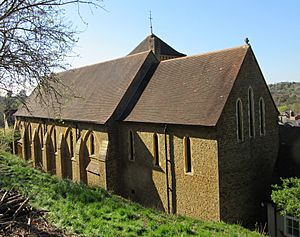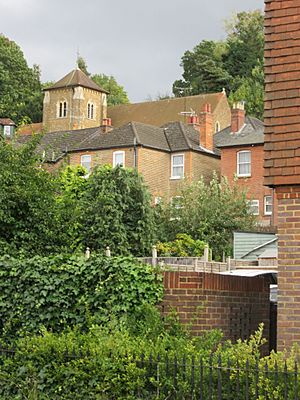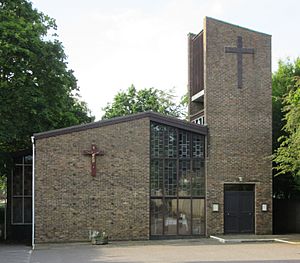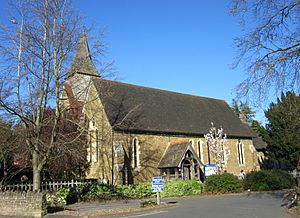St Edmund Church, Godalming facts for kids
Quick facts for kids St Edmund's Church |
|||||||||||||||||||||||||||||||||||||||||||||||||||||||||||||||
|---|---|---|---|---|---|---|---|---|---|---|---|---|---|---|---|---|---|---|---|---|---|---|---|---|---|---|---|---|---|---|---|---|---|---|---|---|---|---|---|---|---|---|---|---|---|---|---|---|---|---|---|---|---|---|---|---|---|---|---|---|---|---|---|
| The Church of St Edmund King and Martyr | |||||||||||||||||||||||||||||||||||||||||||||||||||||||||||||||
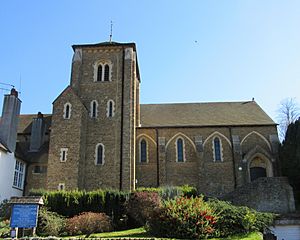
The church viewed from the north
|
|||||||||||||||||||||||||||||||||||||||||||||||||||||||||||||||
|
|||||||||||||||||||||||||||||||||||||||||||||||||||||||||||||||
St Edmund's Church, also known as The Church of St Edmund King and Martyr, is the main Roman Catholic church in Godalming, a town in Surrey, England. It was built in 1906 and designed by Frederick Walters. The church is a special building, listed as Grade II, which means it's important for its history and architecture. It sits on a "dramatic hillside site" near the town centre.
For a long time, after the 1500s, there wasn't a modern Catholic church in Godalming. This town was actually known for its Protestant churches. But by the late 1800s, the Catholic community grew. St Edmund's parish, which is the area the church serves, has always been very large. It covers a wide countryside area in southwest Surrey.
Since the church started in 1899, church services (called Mass) have also been held in other places. These include special churches, converted barns, and halls in nearby villages. St Edmund's still supports a smaller church in Milford. The parish also includes hospitals, convents, and Catholic schools. For many years, a large Polish community has had services led by Polish-speaking priests.
The church itself is described as "fine, if austere." It is built from local stone and looks out over the town. Frederick Walters, who designed St Edmund's, created many churches in the area. Inside, the church has decorations from different times in the 20th century. These include unique bas-relief Stations of the Cross, a beautiful Lady chapel, and stained glass windows by Hardman & Co..
Contents
Catholicism's Return to Godalming
After the English Reformation, the Catholic faith almost disappeared in Surrey. In the late 1500s, only a few Catholics were recorded in Godalming and nearby. By the 1600s, Godalming was known for its strong Protestant beliefs. For a long time, the only Catholic services in west Surrey were held at the Sutton Place estate. This estate was owned by a Catholic family.
In the 1800s, the number of Catholics in Godalming started to grow. By 1860, about 60 local Catholics traveled to Guildford every Sunday for Mass. This continued until 1899. That year, Captain W.H. Rushbrooke bought land in Croft Road. He arranged for a temporary church, called a tin tabernacle, to be built there.
This temporary church opened on November 26, 1899. It was dedicated to Edmund the Martyr, a king from the 9th century. Captain Rushbrooke chose this dedication because he was from Suffolk, where Edmund lived. Captain Rushbrooke was a big supporter of the Catholic Church. He also helped fund the permanent church in Guildford and the first church in Farnham.
Building the Present Church
At first, priests from a friary in Chilworth and the church in Guildford served the tin tabernacle. In 1904, Godalming got its own parish. The first resident priest, Father St George Kieran Hyland, was appointed on November 1, 1904. He was 29 years old and had previously worked at St George's Cathedral, Southwark. Godalming was his first main role as a priest.
Father Hyland quickly saw that a larger, permanent church was needed. He worked to buy land on a "towering bank of undeveloped hillside" further along Croft Road. The land was bought on May 15, 1905. The first stone of the new church was laid on October 8, 1905. Construction finished on June 27, 1906. A local company, David Fry, built the church. The architect was Frederick Walters, who designed over 50 Catholic churches, many in southeast England.
The church cost £4,700 to build. Some money was given anonymously before construction began. After the church opened, fundraising started right away to pay the rest. Father Hyland gave talks and organized events. Once the debt was paid, St Edmund's Church was officially consecrated by Bishop Peter Amigo on October 3, 1923.
Around this time, a new High altar was installed, costing £1,000. A decorative screen called a reredos was also added. Altar rails were put in later in the 1920s. In 1930, the Lady chapel was created at the base of the tower. Also in the mid-1920s, a church hall was built where the old tin tabernacle used to be. The church's windows received stained glass in stages between 1922 and 1950.
Canon Hyland (he became a canon in the early 1920s) passed away in 1950. He had served the parish since 1904. He was buried under the sanctuary of St Edmund's Church in a vault built in 1949. His successor was Father Denis Hawkins, who was known for his writing. During his time, a hall in Elstead was used for worship, and land for a church in Milford was bought.
Church attendance at St Edmund's grew in the late 1950s. This was because a former army barracks in Godalming was used to house refugees from the Hungarian Revolution of 1956. Many of these refugees were Catholic. Godalming already had a large Polish community, and Mass was said in Polish at St Edmund's for many years. After St Joseph's Church was built in Milford, the Polish community often went there. A Polish priest still celebrates Mass there today.
Father Hawkins was followed by Father Maurice Pledger. During his five years, St Joseph's Church in Milford and the Church of Our Lady of Assumption in Elstead opened. This meant the parish now had three churches. Father John McSheehy served for ten years from 1969. He started the first St Edmund's Catholic Primary School. He also began talking with the Anglican Diocese of Guildford. This led to the Anglican church in Farncombe being used for weekly Catholic Masses.
During Father Tony Clarke's time (1980–1990), a new St Edmund's School was built. There were also plans for a large new church next to it. The idea was to replace St Edmund's Church and the smaller churches in Milford and Elstead (Elstead's church closed in 1985). This new church would be a single central place of worship for the whole parish. However, this plan never happened. The land set aside for the church was sold for houses.
After Father Clarke left, the new priest, Father Bernard Rowley, also thought about having one central church. He looked for a site in Godalming town. He even considered an old church building on Bridge Street, but it had too many problems to be used again. Father Michael Perry, who joined in 1994, decided to fix up and improve St Edmund's and St Joseph's churches instead. The old parish hall was sold in 1997 and replaced with flats.
Church Design and Features
St Edmund King and Martyr's Church was given a Grade II listed building status on February 1, 1991. This means it is considered "nationally important and of special interest." It is one of many listed buildings in the Godalming area.
Father Hyland was the main person behind St Edmund's Church. He chose the site and might have influenced the design. Local stories say it was built on a steep hill so its spire would be taller than the steeple of the main parish church, St Peter and St Paul's, which is on lower ground. Frederick Walters made sure the church used its "dramatic hillside site" well.
Walters designed churches in different architectural styles. St Edmund's Church is a simple, "austere" building. Its height and the steep site make it look very impressive. The walls are about 21.5 feet (6.6 m) tall, but inside, the roof reaches 40 feet (12 m) high. The church is 98.5 feet (30 m) long and 21.5 feet (6.6 m) wide.
It is built in the Early English Gothic Revival style. It uses Bargate stone, a rough, light-brown sandstone found locally. This stone was used in many old churches. The walls are smooth, and the roof is tiled. Strong Buttresses support the walls, tower, and entrance porch. The entrance has a pointed (Gothic) arch. All the windows are narrow, tall lancets. The tower has three levels of similar windows and a pointed spire with a weather vane.
When first built, the inside was very plain. Most of the decorations were added later. The Lady Chapel, built in 1930 at the base of the tower, is beautifully decorated. It has a carved reredos and a stone screen. The ceiling and walls have painted patterns, and there is a Madonna statue.
The main altar and carved reredos, which shows saints like Edmund and Thomas of Canterbury, were added in 1923. Most of the stained glass windows are by Hardman & Co.. The west window, from 1937, shows Jesus with St George and St Demetrius. Other windows show scenes like the Annunciation and the Nativity of Jesus. The 14 Stations of the Cross were given anonymously in 1907. They are a rare type of bas-relief design. The font was also given anonymously in the same year. The organ was bought in 1996.
Parish and Other Churches
Godalming parish is one of seven parishes in the Deanery of Guildford. A "parish" is an area served by a church. St Edmund's parish covers a large part of southwest Surrey, about 100 square miles (260 sq km). It used to be even bigger. Today, it borders parishes like Guildford to the north and Haslemere to the south.
There are currently three Catholic communities within the parish. St Edmund's has a smaller "daughter church" in Milford. Also, Catholic Mass is held at the Anglican church in Farncombe. As of 1999, monthly Masses were also held at Ladywell Convent and the Hydon Hill Hospice. The church also serves Milford Hospital. There used to be another daughter church in Elstead until 1985.
Haslemere was the first parish to be created from the original St Edmund's parish. A Mass centre started there in 1908, using the back room of a pub. In 1924, Haslemere got its own parish and priest. The current Church of Our Lady of Lourdes in Haslemere was completed that same year. Bramley was part of Godalming parish until 1955.
St Joseph's Church is in Milford, a village south of Godalming. A member of St Edmund's parish gave land for the church in 1957. Fundraising began, and construction started in 1967, finishing in 1969. The same local company, David Fry, built this church as well. It was designed by Henry Bingham Towner and Partners. The church has a simple design with a tower and seating around a central altar. It was consecrated on Saint Joseph's Day, March 19, 1999.
In Farncombe, the priest from St Edmund's says Mass for local Catholics at the Anglican Church of St John the Evangelist. The idea for a Mass centre in the north of the parish was first discussed in 1971. After talking with the Anglican community, a trial Mass was held on March 11, 1973. It was successful, and the arrangement became official in November 1974.
Money from a weekly building fund, started in 1964, helped build St Joseph's Church in Milford and a permanent church in Elstead. Before World War II, a resident of Elstead asked for Mass to be celebrated in the village. Canon Hyland of St Edmund's Church agreed to send a priest. A temporary chapel was set up in the upper floor of a barn. This was used until 1953, when a former hall was converted into a chapel. In 1968, a prefabricated building became the Church of Our Lady of the Assumption. However, due to a shortage of priests in the 1980s, the church could no longer be served. The last Mass was said in 1985. The building was taken down in 1992.
As of 2015, no Sunday Masses were held at St Edmund's Church itself. A Vigil Mass takes place on Saturdays at 6:00 pm. There are three Masses on Holy Days of Obligation, one of which is in Polish. One Sunday Mass takes place at St Joseph's Church in Milford (10:15 am) and at the Anglican church in Farncombe (8:45 am). Rev. Mirosław Slawicki, one of three Polish priests in the area, is based at St Joseph's Church. He celebrates two Sunday Masses in Polish there each week.
In 2006, a review of the parish showed that the average weekly Mass attendance across all three churches was 427 people. St Edmund's Church could seat 188 people, St Joseph's 192, and St John the Evangelist's in Farncombe 200.
St Edmund's Church is officially registered for worship and for marriages.
See also
- List of places of worship in Waverley (borough)
- Roman Catholic Diocese of Arundel and Brighton


